Archive for category July 2016
Perversion of the Two-Party System
By Kollengode S Venkataraman
This year’s presidential primary season has brought to light the inadequacy of the de-facto 2-party system, which has served the nation reasonably well through several election cycles that include WW I and II and other Wars of Choice and periodic economic convulsions for well over a century, maybe longer. After all, the two strong political forces, the GOP and the Democrats, are both committed to the Constitution, even though they have differentiable ideas on most social, cultural, political, economic, military, environmental, and global issues.
And we have a fairly protracted primary season in which anyone with enough charisma, courage, drive, and ambition can throw their hat in the ring to enter the fray. The protracted primaries with many grueling televised debates give ample opportunities for candidates to project their grasp of the issues facing the offices they seek and the solutions they offer; and also to puncture holes in their opponents’ ideas. The debates also help candidates sharpen their rhetorical skills and burnish their images.
Seeking elected office in the US is a strategic decision. Candidates start years before they decide to enter the race, mulling over the pros and cons, and then building and burnishing their images among the party opinion makers, big-time donors, and leaders.
One good feature of the primary system is that until the candidates get through three-fourths of the primaries, they are on their own. Party officials rarely get into the scene picking favorites even though prominent party members who do not hold official positions do endorse their favorites. But the official party machine scrupulously stays out.
The concept of primaries here is an egalitarian idea. Everybody, irrespective of one’s pedigree or the lack thereof, but fulfilling broad eligibility criteria, can and does enter the ring. This is like the US Open tourneys in tennis or golf. The idea of a primary is drilled down from the highest elected office, namely the Presidency of the United States, to seats in the US Congress, state legislatures, even city council seats.
We have seen candidates with great clout, name recognition, and pedigree falling by the wayside in primaries losing to upstart candidates. This rarely happens in other democracies.
The most famous are Joe Biden, Hillary Clinton, Chris Dodd, John Edwards, all well-known US Senators, losing to an upstart Black first-time US senator named Barack Obama in the 2008 Democratic primaries.
On the GOP side this year was Jeb Bush, former governor of Florida and the scion of the Bush Dynasty, getting eliminated early in the primary. Rick Santorum, Marco Rubio, Rand Paul, and Ted Cruz, all US Senators with clout and name recognition, eventually lost to the upstart, maverick, flamboyant, and cocky Donald Trump, the New York real-estate mogul. Trump never sought any elected office in his life. Further, Trump, having given money to both Democratic and Republican elected officials in the past for smoothing out his real estate dealings, till recently had only condescension for elected officials.
In spite of the good points of the primaries, the de-facto two-party system has been continually perverted over the last several decades by vested interests and special interest groups. Consider these:
Both the GOP and the Democratic parties have become coalitions of special interest groups (SIGs) with only a few of them having overlapping interests. Often, many groups close their eyes to the goals of other groups in the coalition, so long as their interests are protected.
In this evolutionary change, both the GOP and the Democratic Party over the years have become disjointed alliances among SIGs differing among themselves on social and religious matters such as stem cell research, reproductive rights, and contraception; and on public policy issues like immigration, Second Amendment rights, energy, taxation, national debt, healthcare, environment, defense, global trade, etc.
With huge financial stakes on the different parts of the $17 trillion US economy (1 trillion is 1,000,000,000,000), the interests of many of these SIGs within both parties simply cannot converge. So, each group supports the party that serves its interests, often not caring how the interests of other groups in their camp affect the nation’s overall strength. This coalition arrangement has become conflict-ridden for both parties.
Take the healthcare industry as an example. It now accounts for 18% of our GDP. By comparison, this number in terms of GDP is 9% for the UK and Norway; 10% for Japan; 10.4% for Canada; 11% for Germany, Austria and France; and 12% for Sweden. The healthcare dollars in the US economy are over $3 Trillion ($3,000,000,000,000) per year. Honestly for all the extra dollars we spend per capita on health-care, are we any healthier or live any longer than people in these countries? The answer is NO. On many measures, we are even worse.
Obviously, every part of the healthcare industry in the US — hospitals, medical labs, pharma industries, healthcare providers (doctors, nurses, and therapists), insurance companies, lawyers and other businesses servicing the healthcare industry — resists reform because of this bounty compared to other industrialized societies. Similar is the story with the defense budget and expenditure, insurance and banking industries and so on… So, proactive reforms are very difficult.
Complicating this further, in a 5-4 decision in Citizens United v. FEC, the Supreme Court extended the First Amendment rights to corporations. Now corporations can use their funds for campaigning in federal elections. Hiding behind Super PACs, they open their bottomless money bags to campaigns to protect their interests. So, small donors do not count unless candidates vow not to take money from PACs as Sen. Sanders did this primary season.
If you also factor in the totally skewed way in which electoral districts are gerrymandered, one gets the complete picture of why changing the status quo proactively is so very difficult in the US. To understand this look at our own state of Pennsylvania. In statewide elections (presidents, governors, US senators, attorney generals) the vote split between Democrats and Republicans is close — around 53/47 or tighter. But of the 18 US congressmen from the state, 13 are Republicans and only 5 are Democrats. That is what gerrymandering does.
So, with legislators interested only in getting re-elected, we cannot expect them to proactively bring the much needed reforms. Consequently the system goes through periodic convulsions, with the taxpayers eventually footing the bill for bailouts again and again and again.
Mark Twain said this on civilizations: “Every civilization carries the seeds of its own destruction, and the same cycle shows in them all. The Republic is born, flourishes, decays into plutocracy, and is captured by the shoemaker whom the mercenaries and millionaires make into a king.†What he said decades ago makes even more sense today when applied to nation-states such as the US.  ♣
Home
A Heart-Warming Smile in Ramallah, Palestine
By Ramesh G Soni, Ph.D. Â
e-mail:Â rgsoni@yahoo.com
Prof. Ramesh G. Soni, Ph.D., the Chairperson, Department of Management at Indiana University of Pennsylvania, has been living in Indiana, PA with his family for the last twenty-eight years. He recently visited the West Bank, Palestinian Territories on a university exchange program with American Arab University. This was his unique experience interacting with the Palestinian hotel staff.
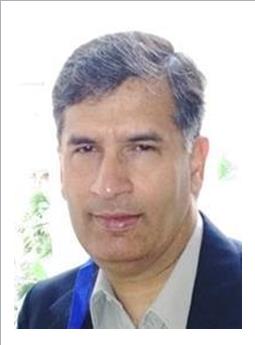
Location: Ramallah, Palestine. As I was working on my laptop in my hotel room, I heard a knock on the door. Raising my voice, I said, “Coming.â€Â I guess the person at the door must have heard my shout as “Come in.â€Â I heard the sound of unlocking of my door and there was this young man — a room service staff with his service cart. He started talking to me in Arabic.
I am used to being mistaken for a local; many Indians can be easily mistaken for Palestinian. Palestine has a broad range of skin tones and facial features — some as white as Caucasians, and as dark as Africans. In fact, in the city of Jericho I had a déjà vu. The restaurant manager, where I had my lunch, reminded me of a service staff at the Rama Krishna Vegetarian Restaurant I used to frequent during my junior college days in Vile Parle, Bombay.
For the moment then, I was really transported down memory lane to my school/junior-college days. I thought, maybe the service staff had immigrated here and opened a restaurant in Jericho. But, wait! There was no Dosa, Idli, Vada or Uttapam on the menu. And, how come the person had not aged a bit in nearly those 40 years!
Going back to the service staff who had just entered my room, he hardly spoke any English. I had a difficult time explaining to him that there was no need to change the bathroom towels or bed sheets — the environmentalist in me cannot accept the wasteful extravagance. I really wanted him to just clean up the coffee cup, get rid of the used tea bags, sugar packets, etc. We were both speaking words — I, English and he, Arabic. But, the real communication was occurring through gestures, facial expressions, and actions. I could sense a disbelief in his eyes — how come this man cannot speak Arabic? Not counting the several OKs he had uttered so far, I finally heard him say two English words: “You where?â€
Ahh…so,he wanted to know where this man was from — the Arab-looking man who cannot speak Arabic. I did not want to confuse him further and decided not to say that I am from the USA—the country that I claim to be mine and where I have been living for the last 32 years. Instead, I told him that I was from India — the country of my birth.
His face brightened instantly. “INDIA! Al Hindi!†he exclaimed! His eyes lit up. He followed it up with the brightest, heart-warming smile and profusely said, “Welcome!  Welcome!!†and a few more Arabic words. “Welcome, Welcome…Welcome!â€Â He was genuinely happy to know that I am from India.
What followed then was something I should have expected as I had a similar experience in my hotel room in Morocco last year. I was trying to be out of the way of the hotel service staff — sitting on a chair in one corner of the room with my laptop, so that he could make my room up efficiently — he continued talking with excitement. I could hear a mix of Arabic words and names of Hindi movies/actors. Jab We Met…Kareena Kapoor… a few more Arabic words… Salman Khan…Shah Rukh Khan…Jab Tak Hai Jaan… more Arabic words. I smiled and nodded to acknowledge his mentioning of several popular Hindi movies and actors.
After making up my room, the hotel staff at my Ramallah hotel welcomed me to Palestine three more times while leaving the room. I was really moved by his love and excitement.
I decided to take a break. I went to the bed, turned the TV on and switched the channel from CNN International to Channel 645—Zee AFLAM. It was showing Oye Luckey, Luckey Oye, starring Abhay Doel.
I couldn’t follow the movie dubbed in Arabic, but I continued watching it. That was the least I could do to thank Bollywood for getting me so much affection and love in many parts of the world.
“Thank you, thank you and thank you Bollywood! Shukran from the bottom of my heart!â€
Note: The Shukran is the same as the Hindi shukriya or the English Thank you.  ♣
Home
The Silk Screen Festival’s 10th Annual Gala
By Nandini Mandal, Pittsburgh, PA
e-mail:Â rinkoo1970@gmail.com
The Silk Screen Film Festival completes ten years this year. Nandini Mandal of the Nandanik Dance Academy talked to Harish Saluja, the dynamo behind the festival, on his exciting and sometime exhausting roller coaster journey in these ten years. The freewheeling interactions took place over dinner at the Bravo Cucina in the Galleria in South Hills in May.
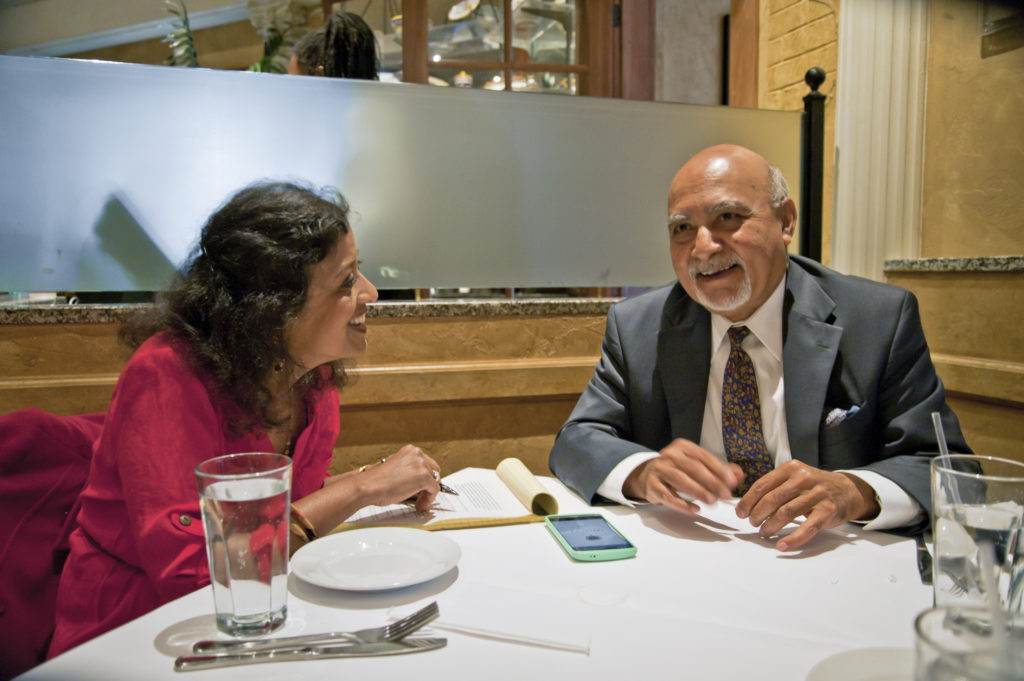
Nandini Mandal talking to Harish Saluja over dinner for the interview. Graphics: Â Alisa Jaconson of Silk Screen Asian Arts.
A young engineering student from IIT Kharagpur biked all the way to the suburbs of Kharagpur to watch Satyajit Ray’s Bengali movie Teen Konya (Three Women). Ray’s movies, unlike popular Hindi potboilers of that era, did not have the hero or the heroine break out into song or dance every half hour or melodramatic endings; nor did they have the gloss and glamour associated with the Bombay film industry, before it became Bollywood. Termed a pioneer in the parallel film industry, Ray’s movies were often considered “Art Films,†winning awards and accolades all over the world, but not always at the box office.
The young engineering student returned to his hostel that night — and to his surprise, found himself drawn towards the same theater the next day, and the next. There was something about that genre of storytelling that drew him back to the South Institute Theater at Kharagpur, and also drove him to learn Bengali so as to understand the nuances of the movies better. It also was the beginning of a new madness for him — Movies. He dreamt of making movies one day. And he did.
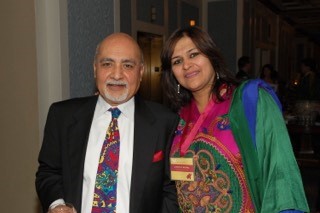
Harish with Sumedha Nagpal, a volunteer with Silk Screen.
That was Harish Saluja, as most of us know him in the greater Pittsburgh region, who also has been running the Music of India radio program with his friend Vijay Bahl for over 30 years now. Saluja loves films, and anything associated with the movie business. It was this ardent passion for films that has given Pittsburgh, and Western PA, The Silk Screen Film Festival, showcasing Asian and Asian-American films from around the world.
As the Silk Screen Festival celebrates its tenth year this year, The Pittsburgh Patrika, wanted to have a candid conversation with the man-behind-the lens — Saluja himself — about his journey in pursuing his passion from conceptualization to its realization, and the future of the festival in the years ahead.
In his usual casual, yet lively and vivacious style, which is natural to him, Saluja led us down his memory lane, starting with What was it that triggered the idea of hosting a film festival?
When he arrived in the USA in the early nineteen-seventies, like most of his generation, he was often surprised that there was so much ignorance about India and Asia among people in the American mainstream. In disbelief, he recalls, “It remained unchanged for a very long time. Among those in the US mainstream, hardly anyone knew about Tyagaraja, Tagore, Nehru, or Ray. There was a dearth of information about the rich cultural heritage of the Indian subcontinent.â€
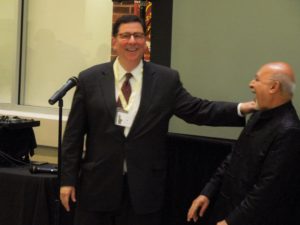
Pittsburgh’s Mayor Bill Peduto cracking a Joke with Harish Saluja.
Saluja remembers how his parents would define and differentiate artists from each other: “I remember my father telling me once, ‘Getting a salary, paying bills, building a house are all equivalent to brushing one’s teeth — nothing out of this world. Everyone has to do it. But giving something to society is different.’
“I remember how my mother would get excited when an artist – whether it was a poet, or a singer, or an instrumentalist visited our house. She kept no stones unturned to ensure that her special guests received the best treatment; and that her son — that’s me — recited his best poem before the guests. And all because they were artists who contribute more than others to the world.â€
Harish, an engineer by profession, and an artist and a musician by hobby, entered into filmmaking out of passion. In retrospect, Harish now thinks, one of his American friends unknowingly started the ball rolling. She told him, “Harish, you know art, you know music, you love films. Why don’t you start something that will help promote your culture to the western world?â€
He had also understood that although Pittsburgh was modern culturally, the city had failed to embrace new immigrants, mostly from Asia. He then quoted Richard Florida who authored Rise of the Creative Class: “People go to places where their lifestyle would be valued.â€
Harish ruefully told me, “There is a Columbus Day parade in Pittsburgh, but there is no Chinese New Year celebration, and the city does not celebrate India Day.â€
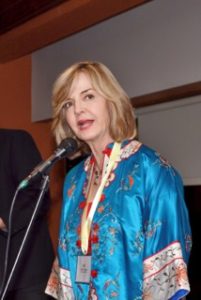
Sally Wiggins, the anchor at WTAE has been supporting Silk Screen as the emcee of the gala.
Then 9/11 happened. Soon there were incidents of mistaken identity — murders of innocent Sikhs who were shot mistaken for Muslims because of their beards and turbans, when, ironically, most Muslims in the US neither wear turbans nor have beards. This goaded him to do something that could make mainstreamers understand Asia and Asians a little better. Having a film background made it an easy decision for him.
He told himself, “It has to be a film festival.†Thus was born The Silk Screen Asian American Film Festival. The name is a play on the phrases silver screen and silk route — defining the genre of movies to be shown at the festival.
When Harish approached Ed Rendell, then governor of Pennsylvania, he got $15,000 in seed money to help start the festival. He continues: “Various foundations, when approached, were very generous. The first festival targeted 500 people to come to the festival. But we were overwhelmed when over 2000 filmgoers came. It was a smashing success, and a great start. There were recognitions and mention internationally. From there, it was no looking back.â€
Saluja and his board of directors, advisors and team of dedicated volunteers decided to expand the festival so that it reached more people in the greater Pittsburgh area itself. It occurred to them that it helped improve the cultural tourism of Pittsburgh and helped bring in the money from the Governor. (This money has since stopped.)
A team of 30 to 40 volunteers from all backgrounds work hard to make the festival a success right from the red carpet gala night to sellin
g tickets. “We were invited by schools, colleges, and museums as this was a great way of showcasing Asian culture and diversity,†he said, and continued: “It was a good medium to educate children about Asian American culture. Then, in association with a few jazz musical geniuses, we formed the Silk Band that had played at the festival in recent years.†As an aside, Harish gleefully mentioned that the Silk Band was invited to play at Peduto’s Mayoral inaugural.
Harish continues: “Collecting funds to bring and showcase films at theaters, host the directors and actors is a Himalayan task. So financially, the road has not been very smooth in the ten years. To give you some idea, typically, 25% of the funds come from foundations, 50% from corporate sponsors. Only the remaining 25% is from individual donations and ticket sales.â€
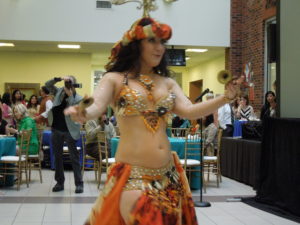
Live performances at the gala.
There have been all types of constraints all along. Changing times and the ups and downs in the economy are making it more difficult for Harish and his team. But the financial constraint is a big one. Says Harish, “The foundations have all cut back on their funding, and the governor’s fund has dried up altogether. The foundations who helped enthusiastically to start the festival, now expect the Festival to become financially self-sustaining.â€
Understandably, with the professional and economic success of Asians in the region getting wide coverage in the media, the big-name donors also expect the festival to get more financial support from the Asian community in Pittsburgh.
Harish does not hide his disappointments: “However, Asian communities have provided very little support for the festival in general. Indians, Chinese, Koreans, Middle-Eastern communities and organizations have not come forward so far to help and financially support and promote the festival, despite the festival showcasing again and again films from Iran, India, Pakistan, Turkey, South Korea, Japan, China, and Malaysia among many other Asian countries. Why is this so? That is something for all Asians to ponder.â€
That Pittsburgh is not a glitzy city compared to Cannes, Venice, Toronto, Singapore, London, Chicago, New York, LA, San Francisco, or Miami, also does not help Harish. He contritely says, “We are not able to attract even tourists to Pittsburgh, nationally or internationally despite the picturesque cityscape surrounded by meandering rivers and hills and countless bridges.â€
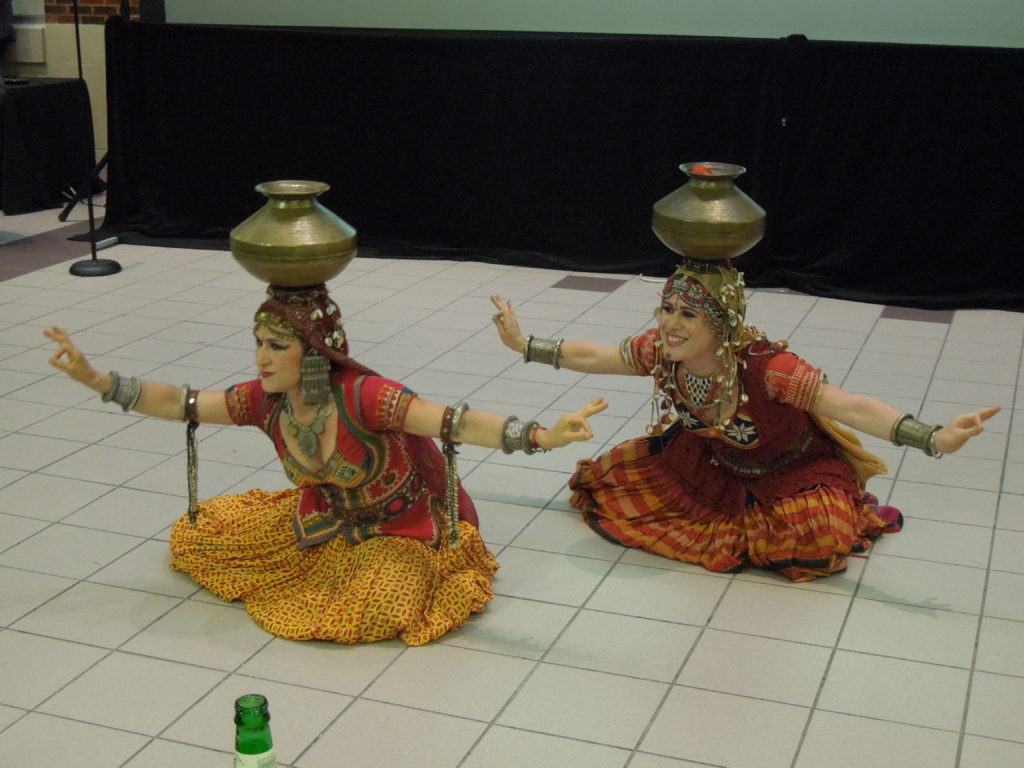
One of the many live performances at the gala.
Understandably, film makers would rather take their creations to festivals that offer awards and award money than come to a city merely to present their movies. Many of his fellow film makers and friends based in London or India say, “Look, we like you, but what would you do if you had a chance to go to a famous festival?†Most film makers want to go to a big-name festival, win an award, get publicity, sell the film, and move on.
The other huge challenge plaguing the festival that outsiders never realize is the rampant piracy of movies in the Indian subcontinent. “Why would one pay to go to a movie that can be seen for free on YouTube or Einthusan on the day of the release?†Harish rhetorically asks.
Amidst these many challenges, the festival is completing its tenth year. Where does Saluja plan to go from here? He is emphatic: “I would like to see more panel discussions or Q&A sessions with actors and directors. The Festival is moving to September this year from its May schedule so that more university students can participate and add verve and energy. This year, films will be showcased at multiple venues across the city — at Regent Square, the Carnegie Museum, the Water Works Mall, the University of Pittsburgh and Carnegie Mellon University.â€
As our freewheeling exchanges winded down, Saluja sounded optimistic: “The festival has evolved into a Pittsburgh tradition and will continue for years to come. The silver screen that takes the audience on a journey through the Silk Route will continue to enthrall thousands.â€
Join The Patrika in congratulating Harish Saluja and his fantastic team on their decade-long journey on this timeless Silk Route, and wishing him many more of these annual gala.
So, come September, “Lights, Camera, Action,†for the festival.   ♣
Home
Taken for Granted
Juginder Luthra, Pittsburgh, PA
Editor’s note: Juginder Luthra wrote this free-style poem based on the vistas of Pittsburgh during day and night including activities on Grandview Avenue. It ends with an eclectic and sophisticated twist, drawing a parallel on how we look at life.
From the balcony, views of Pittsburgh
Awesome, breathtaking, out of this world

Tall varied textured buildings lit bright
Some days soaked in golden sunshine
Embraced at night by fog or moon light
Lip-locked lovers, walkers, bicyclists,
Zippy kids, the old and frail
People throng Viewpoints,
fill benches, line along walking trail
They come hooded, bundled in the thick of freezing winter
Rain gear covered in downpour; bare-chested in summer
Limos dot along Grandview Avenue for special occasion
People arrange festivities for birthdays, weddings or just fun
Great view of town in the Burgh, one of best in the country
Visitors throng from far and near, ranging poorest to highest gentry.

Two beautiful rivers, like two lovers, eager to meet
Where Spring kisses the ground;
Merge, mingle into the Mighty One,
Fountain witnesses new life just begun
With every passing day the thrill of view gets dim and jaded
Starry lights not as bright,
evenings same old dull-’n-faded
Visitors wish for a higher floor for better views and open sky;
Some with acrophobia complain,
wish it was not sickening high.
My nemesis is PPG building;
It blocks flowery dancing fireworks
Its shining glass pillars no longer a marvel to relish
Only draw frowns and smirks.
Monongahela no longer shimmering blue; its water dull, murky brown
Train’s whistle and noise causes conversations to drown.
The Point with its fountain just a sticking finger of land,
Jutted between two rivers where the new one just began.
Days go by haven’t opened the drapes to get a peek
Nothing special happening, the Mon just another creek
Similarly, life gets taken for granted
Our breath, beating heart, ears and eyes,
Every cell working smoothly, non-stop
On demand, without even being asked
Body beautiful gets taken for granted
Miracles of Nature no longer evoke wonder or praised.
Shortcomings, faults, blemishes  are noted
Plastic surgeons, psychiatrists, hospitals kept occupied
Even makers of our body – our parents — forgotten,
often cursed, many a time.
One wrong gene passed among thousands of perfect ones
become actors in crime
Nature or God — whatever or whoever we believe in,
Not thanked, remembered, or acknowledged and now forgotten
Everything gets taken for granted.
Only pitfalls highlighted to grumble and whine.
Complaints take the front stage, highlighted to shine
Views of the Burgh,
Miracles of nature and life
All, with passage of time,
Get taken for granted.
Note: Dr. Kamlesh Aggarwal, a friend of the Luthras, shot the two pictures from the balcony of their condo on Grandview Ave. at different times of the day. The picture at the beginning of the poem was used on the cover of the July issue of the magazine —.  ♣
Home
Funds Raised for 200 EKAL Vidyalaya Schools
 By Jayashree Phanse, Presto, PA
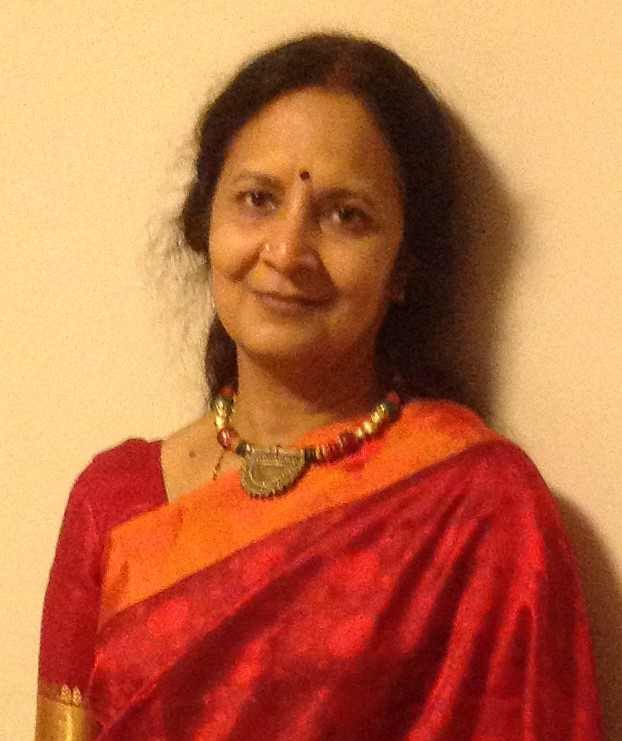 Jayashree, a resident of Pittsburgh for over three decades, is well-known within the Indian community because of her association with the temples and cultural activities. She was a high school teacher in Oakland teaching science, math and computers. She enjoys singing and listening to songs in Indian languages, golfing and social work.
Jayashree, a resident of Pittsburgh for over three decades, is well-known within the Indian community because of her association with the temples and cultural activities. She was a high school teacher in Oakland teaching science, math and computers. She enjoys singing and listening to songs in Indian languages, golfing and social work.
Taking Swami Vivekananda’s exhortation, “If the poor child cannot come to education, then education must go to the child,†to their heart, the EKAL Vidalia Foundation (Foundation of Schools with Single Teacher) has been striving to develop the villages by taking education to interior and tribal India. With the easily achievable goal of frugal literacy for $1/day, EKAL raises funds for training one teacher for a class of 20 to 30 children in the poorest regions of the country.
For raising funds, EKAL organizes concert tours with talented artists from the vibrant Indian TV’s reality shows in different cities of USA. This year’s artistes from Anand Dhun-Anand Swar — Anand Vinod, Vibhavari with Raj Parmar on the keyboard, Dhirendra Dave on the tabla and J. Natu on octapad performed at the Chartier Valley Intermediate School Auditorium on April 30, 2016 with over 500 in the audience. They performed in over 60 cities in the US.
The program started on time with a Saraswati Puja and Moha Desai nicely rendering the Sarawati Dwadasha Naama Stotra. This was followed by Shree Ganeshaya Dheemahi, and the Ekal theme song.
The artists had started their day at 5:30 am to take morning flight, but with the flight getting canceled, they ended up being driven by volunteers from New Jersey, arriving just half hour before the start of the program, with barely any time even to refresh themselves.
Anand Vinod is considered to be one of the Top-10 singers of Kishore Kumar songs. We had to just close our eyes and hear Kishore Kumar coming alive through Anand Vinod. It was indeed a great treat for the diehard fans of this great Bollywood legend. Anand also rendered Mohammad Rafi songs to entertain the Rafi fans as well.
Vibhavari Yadav, the winner of SaReGaMaPa Gujarat 2014 and the Nightingale award in Gujarat, with her pleasant, soothing voice, did not seem one bit tired after almost three hours of singing. Vibhavari presented film songs covering a range of moods sweeping the audience away with her melodies.
Raj Parmar was not only versatile on the key board but was also a good singer. He participated with the lead singers in presenting several songs including duets and group songs. His humorous quips kept the audience attentive in the gaps between the songs. J Natu on the Octapad also sang a smooth song by Mukesh and gave us a short drift in the main show. I must add that Dhirendra Dave’s tabla talent added zest to the program.
There was a short informative video presentation during the intermission filled giving an overview of the EKAL Abhiyaan movement. It was packed with information, taking us from the birth of EKAL through their 26-yeal long journey. Extending itself beyond taking schools to the children and youth, EKAL tries to empower rural families using literacy holistically, on farming issues, health and hygiene, alcohol abuse. India’s Prime Minister Shri Narendra Modi recognized EKAL for having trained more than 52000 teachers educating more than 1.5 million children throughout the remote areas of the country.
The younger generation of Pittsburgh is also donating to this cause, recognizing that the education they have received is a privilege and not a birthright. On this day EKAL received donations for more than 200 schools.
Amazon Shoppers can also participate by choosing EKAL as their choice charity at smile.amazon.com. The entertainment continued till about 11 pm and ended with the Jana Gana Mana displaying the Patriotic element in EKAL.
The first EKAL in Pittsburgh in 2004 conducted at the Hindu Jain Temple with 75 people in the audience and raised money for five schools. This year, funds were raised for more than 200 schools, each receiving $365. Ekal’s Pittsburgh supporters have come a long way.  ♣
Home
Hindu Temples are Getting Americanized… …
 By K S Venkataraman
We go to great lengths to “Indianize†Hindu places of worship in the US by changing their exterior facades with Gopurams and Shikharams and interiors with Hindu murals and architectural features.
However, even as these places maintain a façade of “authenticity,†in reality they have taken a leaf out of the way churches are organized here. Like American Protestant churches, our temples 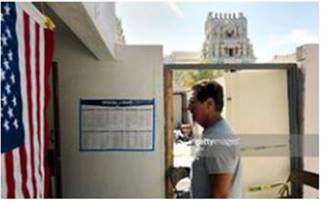 have bylaws, annual membership dues, elections, general body meetings, budget allocations, appointment of employees and priests — and scandals too.
have bylaws, annual membership dues, elections, general body meetings, budget allocations, appointment of employees and priests — and scandals too.
There is nothing new in this. Even animals, when they migrate, learn to adapt to their new ecosystem. That is their only way to survive. Otherwise, they become extinct. Even plants learn to adapt and evolve.
Many temples have also added Indian twists in this adaptation: providing de-facto quota system on the basis of linguistic groups for electing members and temple officers, appointing committees, hiring employees, priests, even cooks. Caste-based reservation is not there, at least not yet! Another feature the temples have most passionately embraced from American churches are fights and schisms spanning from the most trivial to mundane, to serious matters.
Coming from India, one feature that surprised me the most in my early days was the use of places of worship – churches – as polling stations. This is a taboo in India, given the religious strife among and between Hindus, Muslims, and Christians. But then, when I learned more about the early political history of this great nation, I realized that places of worship have always been places where people gathered to discuss politics and social issues, often with church leaders taking a stand on political, social and cultural issues.
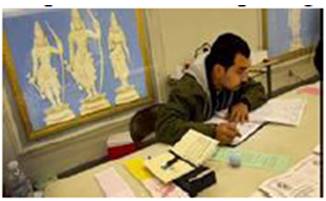 Finally, the Hindu temples in the US seem to be slowly taking a baby step internalizing this one good feature of American democracy. In the recent primary season in California, the Malibu Hindu temple opened its doors as a voting center. The pictures in this story are taken at the Malibu Temple in California, used as polling station in the recent primary.
Finally, the Hindu temples in the US seem to be slowly taking a baby step internalizing this one good feature of American democracy. In the recent primary season in California, the Malibu Hindu temple opened its doors as a voting center. The pictures in this story are taken at the Malibu Temple in California, used as polling station in the recent primary.
The Malibu Hindu Temple, though, is not the first one in setting this good example. The Hindu Samaj Temple in Duchess County in Upstate NY has been doing this for years. Hopefully, other “premier†institutions will follow this good example and become Americanized.  ♣     Â
Home                        Â
Making Authentic Tayir, Dahi, Mosaru, or Perugu
By Kollengode S Venkataraman
My long craving for the authentic home-made dahi (tayir in Tamil and Malayalam, mosaru in Kannada, and perugu in Telugu), recently got satisfied in a totally unexpected way.  Let me preface that this uniquely Indian and perfected home-made product — unique in its texture and taste — goes by the generic name yoghurt in the US.  As Dahi aficionados know only too well, this is only an approximation.
Many of our everyday eats are products of biochemical reactions. Breads — both the freshly baked “artisan†type and the run-of-the-mill types in grocery stores — are “leavened†due to fermentation of bacteria in yeast. Bakeries take great care in preserving the culture of the original strains of bacteria in their starter dough for tens of years so that the breads come out the same way year after year. What makes the French sourdough bread and the Italian bread unique, are the differences in the yeast-enriched starter dough, the flours used, and in the baking techniques. Wines, beers and antibiotics too are products of biochemistry.
The perfect dosas and idlis require that the batter you make by wet-grinding blends of well-soaked urad dal and boiled rice — please do not mistake boiled rice for cooked rice — is allowed to ferment for several hours. The batter acquires a sour taste and is full of gas bubbles (products of fermentation) which make the idlis soft; while making dosas, the batter spreads better on the skillet and the dosas come out with countless small holes when the tiny gas bubbles burst as if by magic design. Indian achars and the Korean kimchi are products of unaerobic fermentation. The Japanese natto, a breakfast item in parts of Japan, is fermented soya beans.
Back to good old authentic tayir that goes by the generic name yoghurt in the US. The desi dahi is very distinct — it has its own texture and taste — and is very different from its distant cousins, zabadi (Arabic), the giaoúrti (Greek) and yoghurt (Turkish). The best dahi I had outside my home is the Brijvasi-type in Delhi. Obviously, the best dahi you know is what your mom made in India.
After arriving in the US, I reconciled myself to the standardized salt-laden buttermilk in cartons and the plain Dannon yoghurt from grocery stores. The fine print on the Dannon container said it contains live acidophilus bacteria. So, I tried to make tayir with 4% milk using Dannon yoghurt as the starter. For those who know nothing about making tayir at home, all that you need to do is:
- Bring ~½ gallon of milk to boil and cool it to room temperature;
- Add approx. two or three tbsp of starter yoghurt to the milk, while gently stirring the milk with a spoon; and
- Let the blend stand overnight at temperatures ~75 F.
When I did this, however, what I got was not the tayir I was used to, but a gooey yoghurt that scooped like a thickened milkshake; worse still, it tasted terrible compared to the tayir I know. I wanted the tayir to handle well — I should be able to cut it into slices like pudding. I also wanted my tayir mellow, and naturally and very mildly sweet (without added sugar) and mildly tart and sour all at the same time, like the tayir my amma made. What I got was not anywhere close.
Having known enough about the effects of time, temperatures and concentration — a subject called chemical reaction kinetics — in my Chem. E. education, I tried all combinations of setting time, temperature and the quality of milk, (different blends of 2% and 4% milk). I ended up with the same gooey stuff, sometime even worse. I gave up, attributing my failure to the type of milk here. This was nearly 15 years ago.
Then recently I was talking to Janaki Raghupathi of Murrysville, shooting the breeze. I’ve known her for over 25 years. I casually told her about my reasoning on why we cannot make good tayir here.
She laughed. “Venkataraman, it has nothing to do with the milk, but everything to do with the starter tayir,†she was categorical. She continued, “Over 30 years ago, I brought with me a small bottle of tayir from my home in India. I used it as a starter material for making tayir at home. I got good tayir from the regular 2% or 4% milk. Every time I make a new batch, I set aside a small portion for the next batch. Why don’t you try with the starter tayir from me.â€
I made the tayir at home using her starter stuff using a blend of 4% and 2% milk. I boiled ½ gallon of the milk and cooled it to room temperature; then added 3 tbsp of Janaki’s starter tayir, gently mixing it into the milk by stirring with a ladle. I kept the mixed blend overnight in the oven chamber of our cooking range with the heat turned OFF. However, the 40-w light in the oven chamber was turned ON to keep the temperature around 75F. This is important during winter.
Next morning, when I stuck a teaspoon into the fermented product, I sliced into it much like the tayir I grew up with in Kerala. I knew right then that this was different. I was excited. With great expectation, I put the spoonful of the tayir into my mouth. Ahh! I was in heaven! I got the same taste of the desi dahi, very mildly sweet, at the same time mildly sour and tart as well — very close to the tayir my mom made decades ago.
So, if you want to make the dahi, tayir, or mosaru, or perugu that you grew up with in India, get some authentic starter material from friends. Follow their instructions to get it right and enjoy it with your family.
When you do this and get the authentic product, I have only one request. Call it by its authentic name, Dahi, Tayir, Perugu, or Mosaru. And never ever call it yoghurt or curd. Because it simply is not, and can never be — the same way French sourdough bread is not the same as the Italian bread.    ♣
Home
Points to Ponder: Muhammad Ali (January 17, 1942 – June 3, 2016)
Muhammad Ali On his opposition to the Vietnam War:
“Why should they ask me to put on a uniform and go ten thousand miles from home and drop bombs and bullets on brown people in Vietnam while so-called Negro people in Louisville are treated like dogs and denied simple human rights?
“No, I am not going ten thousand miles from home to help murder and burn another poor nation simply to continue the domination of white slave masters of the darker people the world over. This is the day when such evils must come to an end. I have been warned that to take such a stand would put my prestige in jeopardy and could cause me to lose millions of dollars which should accrue to me as the champion.
“But I have said it once and I will say it again. The real enemy of my people is right here. I will not disgrace my religion, my people or myself by becoming a tool to enslave those who are fighting for their own justice, freedom and equality…
“If I thought the war was going to bring freedom and equality to 22 million of my people, they wouldn’t have to draft me, I’d join tomorrow. But I either have to obey the laws of the land or the laws of Allah. I have nothing to lose by standing up for my beliefs. So I’ll go to jail. We’ve been in jail for four hundred years.â€
The Greatest’s Other Famous Quotes:
“What you are thinking is what you are becoming.â€
“The man who views the world at 50 the same as he did at 20 has wasted 30 years of his life.â€
“Float like a butterfly and sting like a bee.†  ♣
